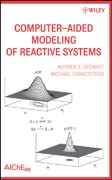
Computer-aided modeling of reactive systems
Stewart, Warren E.
Caracotsios, Michael
INDICE: Chapter 1. Overview. References. Chapter 2. Chemical Reaction Models. 2.1 Stoichiometry of Reaction Schemes. 2.2 Computability of Reaction Rates from Data. 2.3 Equilibria of Chemical Reactions. 2.4 Kinetics of Elementary Steps. 2.5 Properties of Reaction Networks. 2.6 Evidence for Reaction Steps. References. Chapter 3. Chemical Reactor Models. 3.1 Macroscopic Conservation Equations. 3.2 Heat and Mass Transfer in Fixed Beds. 3.3 Interfacial States in Fixed-Bed Reactors. 3.4 Material Transport in Porous Catalysts. 3.4.1 Material Transport in a Cylindrical Pore Segment. 3.4.2 Material Transport in a Pore Network. 3.4.3 Working Models of Flow and Diffusion an Isotropic Media. 3.4.4 Discussion. 3.4.5 Transport and Reaction in Porous Catalysts. 3.5 Gas Properties at Low Pressures. 3.6 Notation. References. Chapter 4. Introduction to Probability and Statistics. 4.1 Strategy of Data-Based Investigation. 4.2 Basic Concepts in Probability Theory. 4.3 Distributions of Sums of Random Variables. 4.4 Multiresponse Normal Error Distributions. 4.5 Statistical Inference and Criticism. References. Chapter 5. Introduction to Bayesian Estimation. 5.1 The Theorem. 5.2 Bayesian Estimation with Informative Priors. 5.3 Introduction to Noninformative Priors. 5.4 Jeffreys Prior for One-Parameter Models. 5.5 Jeffreys Prior for Multiparameter Models. 5.6 Summary. References. Chapter 6. Process Modeling With Single-Response Data. 6.1 The Objective Function S(_). 6.2 Weightingand Observation Forms98. 6.3 Parametric Sensitivities; Normal Equations. 6.4 Constrained Minimization Of S(_). 6.4.1 The Quadratic Programming Algorithm GRQP. 6.4.2 The Line Search Algorithm GRS1. 6.4.3 Final Expansions Around b_. 6.5 Testing the Residuals. 106. 6.6 Inferences from the Posterior Density. 6.6.1Inferences for the Parameters. 6.6.2 Inferences for Predicted Functions. 6.6.3 Discrimination of Rival Models by Posterior Probability. 6.7 Sequential Planning Of Experiments. 6.7.1 Planning For Parameter Estimation. 6.7.2 Planning For Auxiliary Function Estimation. 6.7.3 Planning For Model Discrimination. 6.7.4 Combined Discrimination and Estimation. 6.7.5 Planning For Model Building. 6.8 Examples. 6.9 Summary. 6.10 Notation. References. Chapter 7. Process Modeling With Multiresponse Data. 7.1 Problem Types. 7.2 Objective Function. 7.2.1 Selection of Working Responses. 7.2.2 Derivatives of EQS. (7.2-1) and (7.2-3)150. 7.2.3 Quadratic Expansions; Normal Equations. 7.3 Constrained MinimizationOf S(_. 7.3.1 Final Expansions Around b_. 7.4 Testing the Residual. 7.5 Posterior Probabilities and Regions. 7.5.1 Inferences Regarding Parameters. 7.5.2 Inferences Regarding Functions. 7.5.3 Discrimination among Rival Models. 7.6 Sequential Planning Of Experiments. 7.7 Examples. 7.8 Process Investigations. 7.9 Conclusion. 7.10 Notation. 7.11 Proof of EQS. (7.1-16) and (7.1-17). References. Appendix A. Solution of Linear Algebraic Equations. A.1 Introductory Concepts and Operations. A.2 Operations with Partitioned Matrices. A.3 Gauss-Jordan Reduction. A.4 Gaussian Elimination. A.5 Lu Factorization. A.6 Software. References. Appendix B. Ddaplus Documentation. B.1 What Ddaplus Does. B.2 Object Code. B.3 Calling Ddaplus. B.4 Description of The Calling Arguments. B.5 Exit Conditions and Continuation Calls. B.6 The Subroutine fsub. B.7 The SubroutineEsub. B.8 The Subroutine Jac. B.9 The Subroutine Bsub. B.10numerical Examples. References. Appendix C. Gregplus Documentation. C.1 Description Of Gregplus.C.2 Levels of Gregplus. C.3 Calling Gregplu. C.4 Work Space Requirements for Gregplus. C.5 Specifications For The User-Provided Model. C.6 Single-Response Examples. C.7 Multiresponse Examples. References. Author Index. Subject Index.
- ISBN: 978-0-470-27495-8
- Editorial: John Wiley & Sons
- Encuadernacion: Cartoné
- Páginas: 284
- Fecha Publicación: 04/04/2008
- Nº Volúmenes: 1
- Idioma: Inglés
